View in other NatureServe Network Field Guides
NatureServe
Montana
Utah
Wyoming
Idaho
Wisconsin
British Columbia
South Carolina
Yukon
California
New York
Spalding's Catchfly - Silene spaldingii
Other Names:
Spalding's Campion
State Rank Reason (see State Rank above)
Silene spaldingii exists in only a few locations in the northwest corner of the state. Extant occurrences are known in the following areas: Tobacco Plains area, Lost Trail National Wildlife Refuge, the Niarada area and on Wild Horse Island. The majority of occurrences have less than 100 individuals, though 3 sites are each known to contain over 1,000 individuals and the total population size in Montana is likely 20,000+ mature plants based upon 2011 data. One historical occurrence exists from the Columbia Falls area. Several threats affect the long-term viability of the species in the state. Invasive weeds are the most widespread threat and are negatively impacting the bunchgrass habitat occupied by S. spaldingii. Housing development and subdivision are directly impacting populations in the Tobacco Plains and has the potential to further isolate known occurrences in the area. Cattle grazing is affecting several populations and two other occurrences have apparently been extirpated recently from the severe impacts associated with llama grazing. Fire exclusion and the successive build-up of litter compared to historical conditions appears to be having negative impacts on survival and reproduction. Populations are also at risk due to the small numbers of individuals and their isolated nature, which reduces the chances of cross-pollination and gene flow between populations.
Long- and short-term trends are difficult to gauge due to the lack of survey and monitoring data. Estimates of trends and population size are also compounded by S. spaldingii plants exhibiting summer dormancy at rates that vary widely from year to year.
- Details on Status Ranking and Review
Population Size
Score1 - Moderate: Generally 10,000-100,000 individuals.
Range Extent
Score2 - Regional or State Endemic or Small Montana Range: Generally restricted to an area <100,000 sq. miles (equivalent to 2/3 the size of Montana or less) or Montana contributes 50% or more of the species’ range or populations OR limited to 2-3 Sub-basins in Montana.
Area of Occupancy
Score2 - Low: Generally occurring in 4-10 Subwatersheds (6th Code HUC’s).
Environmental Specificity
Score2 - High: Species is restricted to a highly specialized and limited habitat and is typically dependent upon unaltered, high-quality habitat (C Values of 8-10).
Trends
Score1-3 - Declining: Species is likely declining though the magnitude of declines is uncertain. Declines may be based upon range extent and/or occupied area in the recent past (approximately 30 years).
CommentTrends are not well-documented, though the species has experienced some declines in the state.
Threats
Score2-3 - High to Very High.
CommentDevelopment, invasive species and grazing are the primary threats.
Intrinsic Vulnerability
Score2 - High Vulnerability: Very specific biological attributes, unusual life history characteristics or limited reproductive potential makes the species highly susceptible to extirpation from stochastic events or other adverse impacts to its habitat and very slow to recover.
Raw Conservation Status Score
Score
12 to 15 total points scored out of a possible 19.
General Description
Spalding's Catchfly is a perennial with a simple or branched rootcrown. There are 4-7 pairs of sessile, broadly lance-shaped leaves that are 6-7 cm long below and gradually reduced in size upward. Herbage is long-hairy and very sticky. There are few to many flowers in a leafy, somewhat open inflorescence. The tubular calyx is ca. 15 mm long, has 10 nerves on its surface, and is very sticky. The corolla has 5 separate, white petals, each composed of a narrow claw that is ca. 15 mm long expanding into a broadened blade above. Only the entire or shallowly-lobed blade with 4 tiny wings at the base protrudes beyond the mouth of the calyx. The fruit is a capsule that is 10-15 mm long and filled with numerous tiny seeds.
Phenology
Flowering in July and usually continuing through August. Dried flower/fruiting stalks are often visible into the Fall.
Diagnostic Characteristics
This species can be distinguished from other perennial Silene spp. by its very sticky foliage and by its petals that are entire or only shallowly lobed.
Species Range
Montana Range
Range Descriptions
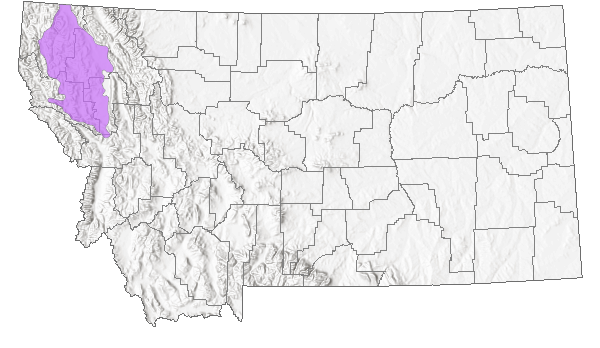
 Native
Native
Range Comments
Regional endemic restricted to remnants of the Palouse Prairie grasslands of eastern Washington, northeastern Oregon, northern Idaho, and western Montana (barely extending into British Columbia, Canada).
Observations in Montana Natural Heritage Program Database
Number of Observations: 1027
(Click on the following maps and charts to see full sized version)
Map Help and Descriptions
Relative Density

Recency
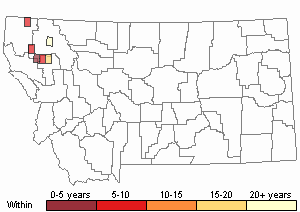
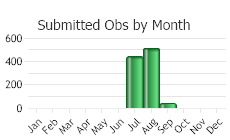
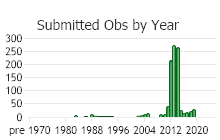
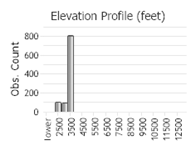 (Observations spanning multiple months or years are excluded from time charts)
(Observations spanning multiple months or years are excluded from time charts)
Habitat
Open, mesic grasslands in the valleys and foothills usually with rough fescue, Nelson's needlegrass, Richardson's needlegrass and Idaho fescue. Occasionally with scattered ponderosa pine or broadleaf shrubs. Soils are usually deep and loamy. S. spaldingii typically occurs on northerly aspects and along draws and swales.
National Vegetation Classification System Groups Associated with this Species
Forest and Woodland
Low Elevation - Xeric Forest and Woodland
Montane - Subalpine Forest and Woodland
Shrubland
Foothills - Montane Shrubland
Grassland
Lowland - Prairie Grassland
Montane - Subalpine Grassland
Ecology
1. Reproductive Biology and Phenology:
Silene spaldingii is a perennial herb capable of living at least five years (Lesica 1997) and is dependent solely on reproduction from seed. Flowers are perfect and protandrous (anthers mature, dehisce pollen and wither before the styles expand and stigmas become receptive) (Lesica 1993). This reproductive strategy limits, though does not exclude, self-pollination. Seeds apparently germinate in the spring and continue to grow while soil moisture is adequate and temperatures are moderate. Plants have been observed as early as May 22 at Dancing Prairie (Lesica 1997). Aboveground parts of the seedling plants/rosettes dry up and are senescent during the hottest, driest parts of the summer. Plants may then revive with the onset of cool, moist weather in the fall (Lesica 1988). Flowering may take place during or after the second year with flowers developing in July and August. Each open flower persists for two or more days, and several flowers may be in bloom on the same plant allowing for pollination to occur from flowers on the same plant (geitonogamy). Individual plants flower for 2-3 weeks. Fruits of dehiscent capsules contain up to 150 seeds and mature primarily in August (Lesica 1993). Seeds require a short cold treatment for effective germination and may germinate in the fall as well as the spring following as little as four weeks of cold treatment (Lesica 1993, 1999).
The pollination biology of
S. spaldingii has been studied by Lesica (1993) and Lesica and Heidel (1996). In Montana, the only pollinators observed visiting
S. spaldingii plants were bumblebees (
Bombus fervidus). Studies of
S. spaldingii pollinators in Montana are limited to the Dancing Prairie population. As noted earlier, self-pollination is possible, though Lesica's study (1993) showed very highly reduced levels of fitness for progeny of close-pollinated flowers (bagged plants) versus open-pollinated flowers.
Potential and Known Pollinators:
The following animal species have been reported as pollinators of this plant species or its genus where their geographic ranges overlap:
Bombus vagans,
Bombus pensylvanicus, and
Bombus impatiens (Colla and Dumesh 2010).
2. Species Ecology:
Silene spaldingii occupies mesic sites within Palouse grasslands. Generally, plants are found on northerly aspects, in swales or along small draws where it is presumed more moisture remains available during the hot, dry summer months of July and August.
S. spaldingii is atypical in that it flowers in July and August in a habitat when most other species have already completed flowering for the season. One potential advantage of this strategy is that it is not competing for pollinators. However, precipitation is usually scarce during this time period resulting in unfavorable soil moisture conditions for plant growth. Potentially in response to these dry conditions,
S. spaldingii plants may remain dormant in some years. It is unclear if this dormancy is a response to the reduced moisture availability in the previous year, dry conditions during part of the current growing season, some combination of these or to some other factor (Lesica 1999, Lesica and Steele 1994). To date, a correlation between precipitation patterns and dormancy has not been made, though plants do apparently show a strong biennial periodicity (Lesica 1997). On-going demographic monitoring conducted by Lesica should help provide answers.
At Dancing Prairie, Lesica (1997) found that an average of 41% of
S. spaldingii plants between 1989 and 1994 exhibited annual dormancy and that dormancy rates ranged from 11% in 1989 to 74% in 1994. Dormancy lasted one year in 75% of the observed episodes and no more than two years in 90% of the cases. The study also found that plants spent nearly half their summers in a dormant condition during the six year period. [from Mincemoyer 2005]
Stewardship Responsibility
Threats or Limiting Factors
STATE THREAT SCORE REASON
Reported threats to Montana's population of Spalding’s Catchfly primarily concern invasive non-native species found at all population locations. Noxious weeds including Sulphur Cinquefoil (Potentilla recta), Spotted Knapweed (Centaurea stoebe), Canada thistle (Cirsium arvense), Common St. John's-wort (Hypericum perforatum), Dalmatian Toadflax (Linaria dalmatica), and Wiregrass (Ventenata dubia) are present and expanding at many Spalding’s Catchfly sites. Co-occurring noxious species are difficult to control and have destructive negative feedback impacts on native populations. Chemical herbicides used to control invasive plant outbreaks directly destroy individuals and expand habitat degradation. At least two populations are extirpated following a severe invasion. Other reported threats include livestock grazing and fire suppression. Ground disturbance from livestock trampling aids the spread of non-natives. Fire suppression is a reported threat known for negative impacts to Spalding’s Catchfly recruitment and survival (MTNHP Threat Assessment 2021).
References
- Literature Cited AboveLegend:
 View Online Publication
View Online Publication Lesica, P., M.T. Lavin, and P.F. Stickney. 2012. Manual of Montana Vascular Plants. Fort Worth, TX: BRIT Press. viii + 771 p.
Lesica, P., M.T. Lavin, and P.F. Stickney. 2012. Manual of Montana Vascular Plants. Fort Worth, TX: BRIT Press. viii + 771 p. MTNHP Threat Assessment. 2021. State Threat Score Assignment and Assessment of Reported Threats from 2006 to 2021 for State-listed Vascular Plants. Botany Program, Montana Natural Heritage Program, Helena, Montana.
MTNHP Threat Assessment. 2021. State Threat Score Assignment and Assessment of Reported Threats from 2006 to 2021 for State-listed Vascular Plants. Botany Program, Montana Natural Heritage Program, Helena, Montana.
- Additional ReferencesLegend:
 View Online Publication
View Online Publication
Do you know of a citation we're missing? Atwood, D., and N. Charlesworth. 1987. Status report for Silene spaldingii. USDA Forest Service, Intermountain Region, Ogden, UT. Not paged.
Atwood, D., and N. Charlesworth. 1987. Status report for Silene spaldingii. USDA Forest Service, Intermountain Region, Ogden, UT. Not paged. Baldwin, C.T., and S.J. Brunsfeld. 1995. Preliminary genetic analysis of Silene spaldingii (Spalding's catchfly), a candidate threatened species. Wildland Plant Ecogenetics Cooperative, University of Idaho, in cooperation with Montana Natural Heritage Program. Not paged.
Baldwin, C.T., and S.J. Brunsfeld. 1995. Preliminary genetic analysis of Silene spaldingii (Spalding's catchfly), a candidate threatened species. Wildland Plant Ecogenetics Cooperative, University of Idaho, in cooperation with Montana Natural Heritage Program. Not paged. Brooks, P. J., K. Urban, E. Yates, and C. G. Johnson, Jr. 1991. Sensitive plants of the Malheur, Ochoco, Umatilla, and the Wallowa-Whitman National Forests. U.S. Department of Agriculture, Forest Service, Pacific Northwest Region. Not paged.
Brooks, P. J., K. Urban, E. Yates, and C. G. Johnson, Jr. 1991. Sensitive plants of the Malheur, Ochoco, Umatilla, and the Wallowa-Whitman National Forests. U.S. Department of Agriculture, Forest Service, Pacific Northwest Region. Not paged. Caplow, F. 2002. Annual report for Spalding’s catchfly (Silene spaldingii) on Fairchild AFB, Washington. Washington State Department of Natural Resources, Natural Heritage Program, Olympia, Washington. 11 pp. + appendices.
Caplow, F. 2002. Annual report for Spalding’s catchfly (Silene spaldingii) on Fairchild AFB, Washington. Washington State Department of Natural Resources, Natural Heritage Program, Olympia, Washington. 11 pp. + appendices. Cooper, S.V. 2003. Assessment of Kootenai National Forest vegetation types with potential for Silene spaldingii in the Tobacco Plains, Rexford Bench and Salish Range foothills. Unpublished report to Kootenai National Forest, Supervisor's Office. Montana Natural Heritage Program, Helena, MT. 33 pp. plus appendices.
Cooper, S.V. 2003. Assessment of Kootenai National Forest vegetation types with potential for Silene spaldingii in the Tobacco Plains, Rexford Bench and Salish Range foothills. Unpublished report to Kootenai National Forest, Supervisor's Office. Montana Natural Heritage Program, Helena, MT. 33 pp. plus appendices. Cope, M.G. 1992. Distribution, habitat selection and survival of transplanted Columbian Sharp-tailed Grouse (Tympanuchus phasianellus columbianus) in the Tobacco Valley, Montana. M.Sc. Thesis. Bozeman, Montana: Montana State University. 60 p.
Cope, M.G. 1992. Distribution, habitat selection and survival of transplanted Columbian Sharp-tailed Grouse (Tympanuchus phasianellus columbianus) in the Tobacco Valley, Montana. M.Sc. Thesis. Bozeman, Montana: Montana State University. 60 p. Gamon, J. 1991. Report on the status of Silene spaldingii Wats. in Washington. Unpublished report, Washington Natural Heritage Program, Olympia, Washington. 53 pp.
Gamon, J. 1991. Report on the status of Silene spaldingii Wats. in Washington. Unpublished report, Washington Natural Heritage Program, Olympia, Washington. 53 pp. Heidel, B. 1979. Endangered and threatened plants in the Northern Idaho BLM District. Unpublished report. 100 pp.
Heidel, B. 1979. Endangered and threatened plants in the Northern Idaho BLM District. Unpublished report. 100 pp. Heidel, B.L. 1980. Silene spaldingii. Unpublished report. U.S. Fish and Wildlife Service, Portland, Oregon. 13 pp.
Heidel, B.L. 1980. Silene spaldingii. Unpublished report. U.S. Fish and Wildlife Service, Portland, Oregon. 13 pp. Heidel, B.L. 1995. Preliminary status report for Silene spaldingii (Spalding's catchfly), a candidate threatened species. Unpublished report (draft) submitted to accompany Montana comments on the 1993 Federal Register Notice of Review for plants. Montana Natural Heritage Program, Helena, Montana. 10 pp. plus appendices.
Heidel, B.L. 1995. Preliminary status report for Silene spaldingii (Spalding's catchfly), a candidate threatened species. Unpublished report (draft) submitted to accompany Montana comments on the 1993 Federal Register Notice of Review for plants. Montana Natural Heritage Program, Helena, Montana. 10 pp. plus appendices. Hill, J. L. and K. L. Gray. 2004. Conservation strategy for Spalding's catchfly (Silene spaldingii Wats.). Idaho Department of Fish and Game Conservation Data Center, Boise, ID. 161 pp.
Hill, J. L. and K. L. Gray. 2004. Conservation strategy for Spalding's catchfly (Silene spaldingii Wats.). Idaho Department of Fish and Game Conservation Data Center, Boise, ID. 161 pp. Hitchcock, C. L., A. Cronquist, M. Ownbey, and J. W. Thompson. 1964. Vascular Plants of the Pacific Northwest. Part 2: Salicaceae to Saxifragaceae. University of Washington Press, Seattle. 597 pp.
Hitchcock, C. L., A. Cronquist, M. Ownbey, and J. W. Thompson. 1964. Vascular Plants of the Pacific Northwest. Part 2: Salicaceae to Saxifragaceae. University of Washington Press, Seattle. 597 pp. Hitchcock, C. L., and B. Maguire. 1947. A revision of the North American species of Silene. University of Washington Publications in Biology, Vol. 13. University of Washington Press, Seattle. 73 pp.
Hitchcock, C. L., and B. Maguire. 1947. A revision of the North American species of Silene. University of Washington Publications in Biology, Vol. 13. University of Washington Press, Seattle. 73 pp. Hitchcock, C.L. and B. Maguire. 1947. North American species of Silene. University of Washington Publications in Biology 13:28-33.
Hitchcock, C.L. and B. Maguire. 1947. North American species of Silene. University of Washington Publications in Biology 13:28-33. Kagan, J. 1989. Draft species management guide for Silene spaldingii. Unpublished report to the Oregon Department of Agriculture, Wallowa Whitman National Forest. 13 pp.
Kagan, J. 1989. Draft species management guide for Silene spaldingii. Unpublished report to the Oregon Department of Agriculture, Wallowa Whitman National Forest. 13 pp. Kautz, D. R. 1981. Range and wildlife resources of Wild Horse Island, Flathead Lake, Montana. M.S. Thesis. University of Montana, Missoula. 241 pp.
Kautz, D. R. 1981. Range and wildlife resources of Wild Horse Island, Flathead Lake, Montana. M.S. Thesis. University of Montana, Missoula. 241 pp. Kruckeberg, A. R. 1961. Artificial crosses of western North American Silenes. Brittonia 13. 305-333.
Kruckeberg, A. R. 1961. Artificial crosses of western North American Silenes. Brittonia 13. 305-333. Lesica, P. 1986. Monitoring of a population of the rare plant Silene spaldingii on Wildhorse Island. Unpublished report on file at the Montana Natural Heritage Program, Helena, MT. 3 pp.
Lesica, P. 1986. Monitoring of a population of the rare plant Silene spaldingii on Wildhorse Island. Unpublished report on file at the Montana Natural Heritage Program, Helena, MT. 3 pp. Lesica, P. 1988. A preliminary study of the pollination biology of Spalding's Catchfly in the Tobacco Valley, Lincoln County, Montana. Unpublished paper prepared for The Nature Conservancy, Montana/Wyoming Office, Helena, MT. 5 pp.
Lesica, P. 1988. A preliminary study of the pollination biology of Spalding's Catchfly in the Tobacco Valley, Lincoln County, Montana. Unpublished paper prepared for The Nature Conservancy, Montana/Wyoming Office, Helena, MT. 5 pp. Lesica, P. 1988. Germination requirements and seedling biology of Spalding's catchfly (Silene spaldingii). The Nature Conservancy, Montana/Wyoming Field Office, Helena, MT. 2 pp.
Lesica, P. 1988. Germination requirements and seedling biology of Spalding's catchfly (Silene spaldingii). The Nature Conservancy, Montana/Wyoming Field Office, Helena, MT. 2 pp. Lesica, P. 1988. Monitoring Silene spaldingii on Dancing Prarie Preserve: 1988 progress report. Unpublished paper prepared for The Nature Conservancy, Montana/Wyoming Office, Helena, MT. 4 pp.
Lesica, P. 1988. Monitoring Silene spaldingii on Dancing Prarie Preserve: 1988 progress report. Unpublished paper prepared for The Nature Conservancy, Montana/Wyoming Office, Helena, MT. 4 pp. Lesica, P. 1988. Monitoring Silene spaldingii on Wild Horse Island: 1988 progress report. Unpublished paper prepared for The Nature Conservancy, Montana/Wyoming Office, Helena, MT. 3 pp.
Lesica, P. 1988. Monitoring Silene spaldingii on Wild Horse Island: 1988 progress report. Unpublished paper prepared for The Nature Conservancy, Montana/Wyoming Office, Helena, MT. 3 pp. Lesica, P. 1991. Inbreeding depression and the importance of pollinators to the threatened plant, Silene spaldingii (Caryophyllaceae). Unpublished report prepared for The Nature Conservancy, Montana Field Office, Helena. 15 p.
Lesica, P. 1991. Inbreeding depression and the importance of pollinators to the threatened plant, Silene spaldingii (Caryophyllaceae). Unpublished report prepared for The Nature Conservancy, Montana Field Office, Helena. 15 p. Lesica, P. 1992. Monitoring Silene spaldingii on Dancing Prairie Preserve: 1992 progress report. Unpublished report. The Nature Conservancy, Montana Field Office, Helena, Montana. 9 pp. plus charts.
Lesica, P. 1992. Monitoring Silene spaldingii on Dancing Prairie Preserve: 1992 progress report. Unpublished report. The Nature Conservancy, Montana Field Office, Helena, Montana. 9 pp. plus charts. Lesica, P. 1992. Monitoring Silene spaldingii on Wild Horse Island: 1992 progress report. Unpublished report. The Nature Conservancy, Montana Field Office, Helena, Montana. 8 pp. plus charts.
Lesica, P. 1992. Monitoring Silene spaldingii on Wild Horse Island: 1992 progress report. Unpublished report. The Nature Conservancy, Montana Field Office, Helena, Montana. 8 pp. plus charts. Lesica, P. 1992. The effects of fire on Silene spaldingii. 1992 progress report. Montana Natural Heritage Program, Helena. 14 pp.
Lesica, P. 1992. The effects of fire on Silene spaldingii. 1992 progress report. Montana Natural Heritage Program, Helena. 14 pp. Lesica, P. 1993. Loss of fitness resulting from pollinator exclusion in Silene spaldingii (Caryophyllaceae). Madrono 40(4): 193-201.
Lesica, P. 1993. Loss of fitness resulting from pollinator exclusion in Silene spaldingii (Caryophyllaceae). Madrono 40(4): 193-201. Lesica, P. 1993. The effects of fire on Silene spaldingii at Dancing Prairie Preserve. Unpublished report to the Montana Nature Conservancy, Helena, Montana. 14 pp.
Lesica, P. 1993. The effects of fire on Silene spaldingii at Dancing Prairie Preserve. Unpublished report to the Montana Nature Conservancy, Helena, Montana. 14 pp. Lesica, P. 1994. Monitoring Silene spaldingii on Dancing Prairie Preserve: 1993 progress report prepared for The Nature Conservancy, Helena, Montana. 10 pp.
Lesica, P. 1994. Monitoring Silene spaldingii on Dancing Prairie Preserve: 1993 progress report prepared for The Nature Conservancy, Helena, Montana. 10 pp. Lesica, P. 1997. Demography of the endangered plant, Silene spaldingii (Caryophyllaceae) in northwest Montana. Madrono 44(4):347-358.
Lesica, P. 1997. Demography of the endangered plant, Silene spaldingii (Caryophyllaceae) in northwest Montana. Madrono 44(4):347-358. Lesica, P. 1997. The effects of fire on Silene spaldingii at Dancing Prairie Preserve. Draft final report prepared for The Nature Conservancy, Helena, Montana. 27 pp.
Lesica, P. 1997. The effects of fire on Silene spaldingii at Dancing Prairie Preserve. Draft final report prepared for The Nature Conservancy, Helena, Montana. 27 pp. Lesica, P. 1999. Effects of fire on the demography of the endangered, geophytic herb Silene spaldingii (Caryophyllaceae). American Journal of Botany 86(7):996-1002.
Lesica, P. 1999. Effects of fire on the demography of the endangered, geophytic herb Silene spaldingii (Caryophyllaceae). American Journal of Botany 86(7):996-1002. Lesica, P. 2003. Comments on the draft conservation strategy for Silene spaldingii from The Nature Conservancy of Montana - 11/15/2003. Helena, MT. 6 pp.
Lesica, P. 2003. Comments on the draft conservation strategy for Silene spaldingii from The Nature Conservancy of Montana - 11/15/2003. Helena, MT. 6 pp. Lesica, P. 2004. Monitoring population trend of Silene spaldingii on Dancing Prairie Preserve 2004 progress report. Prepared for The Nature Conservancy. Helena, MT. 5 pp.
Lesica, P. 2004. Monitoring population trend of Silene spaldingii on Dancing Prairie Preserve 2004 progress report. Prepared for The Nature Conservancy. Helena, MT. 5 pp. Lesica, P. and B. Heidel. 1996. Pollination biology of Silene spaldingii. Unpublished report to the Montana Field Office of The Nature Conservancy. Montana Natural Heritage Program.
Lesica, P. and B. Heidel. 1996. Pollination biology of Silene spaldingii. Unpublished report to the Montana Field Office of The Nature Conservancy. Montana Natural Heritage Program. Lesica, P. and E. Crone. 2004. Demographic monitoring of Silene spaldingii at four sites in Montana and Washington. 5 pp.
Lesica, P. and E. Crone. 2004. Demographic monitoring of Silene spaldingii at four sites in Montana and Washington. 5 pp. Lesica, P., M.T. Lavin, and P.F. Stickney. 2022. Manual of Montana Vascular Plants, Second Edition. Fort Worth, TX: BRIT Press. viii + 779 p.
Lesica, P., M.T. Lavin, and P.F. Stickney. 2022. Manual of Montana Vascular Plants, Second Edition. Fort Worth, TX: BRIT Press. viii + 779 p. Lesica, Peter and Dave Hanna. 2017. Monitoring Silene spaldingii Population Trends on Dancing Prairie Preserve, 2016 Baseline Final Report. January. Prepared by The Nature Conservancy, Choteau, Montana.
Lesica, Peter and Dave Hanna. 2017. Monitoring Silene spaldingii Population Trends on Dancing Prairie Preserve, 2016 Baseline Final Report. January. Prepared by The Nature Conservancy, Choteau, Montana. Lichthardt, J.J. 1997. Revised report on the conservation status of Silene spaldingii in Idaho. Unpublished report to the U.S. Fish and Wildlife Service. Idaho Conservation Data Center, Boise, Idaho. 19 pp. plus appendices.
Lichthardt, J.J. 1997. Revised report on the conservation status of Silene spaldingii in Idaho. Unpublished report to the U.S. Fish and Wildlife Service. Idaho Conservation Data Center, Boise, Idaho. 19 pp. plus appendices. Lorain, C.C. 1991. Report on the conservation status of Silene spaldingii in Idaho. Prepared for: Idaho Department of Parks and Recreation. Unpublished report on file at: Idaho Department of Fish and Game, Conservation Data Center, Boise. 29 pp. plus appendices.
Lorain, C.C. 1991. Report on the conservation status of Silene spaldingii in Idaho. Prepared for: Idaho Department of Parks and Recreation. Unpublished report on file at: Idaho Department of Fish and Game, Conservation Data Center, Boise. 29 pp. plus appendices. Mancuso, M., and R. Moseley. 1994. Vegetation description, rare plant inventory, and vegetation monitoring for Craig Mountain, Idaho. Unpublished report prepared for Bonneville Power Administration. 146 pp.
Mancuso, M., and R. Moseley. 1994. Vegetation description, rare plant inventory, and vegetation monitoring for Craig Mountain, Idaho. Unpublished report prepared for Bonneville Power Administration. 146 pp. Matt, D. F. 2000. Tribal comments to proposed listing of Spalding’s catchfly as threatened pursuant to the Endangered Species Act. Letter to the U.S. Fish and Wildlife Service, Boise, ID. January 27, 2000. The Confederated Salish and Kootenai Tribes, Pabl
Matt, D. F. 2000. Tribal comments to proposed listing of Spalding’s catchfly as threatened pursuant to the Endangered Species Act. Letter to the U.S. Fish and Wildlife Service, Boise, ID. January 27, 2000. The Confederated Salish and Kootenai Tribes, Pabl Mincemoyer, S. 2005. Conservation strategy for Silene spaldingii (Spalding's catchfly) in Montana. Prepared for the U.S. Fish and Wildlife Service. Montana Natural Heritage Program, Helena, MT. 39 pp. + appendices.
Mincemoyer, S. 2005. Conservation strategy for Silene spaldingii (Spalding's catchfly) in Montana. Prepared for the U.S. Fish and Wildlife Service. Montana Natural Heritage Program, Helena, MT. 39 pp. + appendices. Morrison-Maierle. 1988. Draft Eureka airport master plan study: Chapter 5 - environmental assessment. 32 pp plus appendices.
Morrison-Maierle. 1988. Draft Eureka airport master plan study: Chapter 5 - environmental assessment. 32 pp plus appendices. Pipp, A. 2015. Summary of work completed in 2015 on the Confederated Salish-Kootenai Tribal Land under a Natural Resource Collection Permit for Surveys and Monitoring for Spalding's Catchfly. Helena, MT: Montana Natural Heritage Program. 51 p.
Pipp, A. 2015. Summary of work completed in 2015 on the Confederated Salish-Kootenai Tribal Land under a Natural Resource Collection Permit for Surveys and Monitoring for Spalding's Catchfly. Helena, MT: Montana Natural Heritage Program. 51 p. Pipp, A. 2019. Memorandum reporting on the 2019 Spalding's Catchfly (Silene Spaldingii) Data Collection in Montana: Species Occurrence (SO) re-visits on the Flathead Indian Reservation. Memorandum to the Confederated Salish Kootenai Tribe and U.S. Fish and Wildlife Service. 2 May 2019. 7 pp plus appendices.
Pipp, A. 2019. Memorandum reporting on the 2019 Spalding's Catchfly (Silene Spaldingii) Data Collection in Montana: Species Occurrence (SO) re-visits on the Flathead Indian Reservation. Memorandum to the Confederated Salish Kootenai Tribe and U.S. Fish and Wildlife Service. 2 May 2019. 7 pp plus appendices. Pipp, A. 2019. Three-year baseline monitoring study for Silene spaldingii on the Flathead Indian Reservation: Year 2018. Montana Natural Heritage Program, Helena, Montana.
Pipp, A. 2019. Three-year baseline monitoring study for Silene spaldingii on the Flathead Indian Reservation: Year 2018. Montana Natural Heritage Program, Helena, Montana. Pipp, Andrea. 2018. Three-Year Baseline Monitoring Studies for Silene spaldingii on the Flathead Indian Reservation: Year 2017. Montana Natural Heritage Program, Helena, Montana.
Pipp, Andrea. 2018. Three-Year Baseline Monitoring Studies for Silene spaldingii on the Flathead Indian Reservation: Year 2017. Montana Natural Heritage Program, Helena, Montana. Pipp, Andrea. 2020. Memorandum reporting on the 2019 Spalding's Catchfly (Silene Spaldingii) Data Collection in Montana. Prepared for the Confederated Salish and Kootenai Tribes of the Flathead Reservation, Pablo, Montana and U.S. Fish and Wildlife Service, Montana Ecological Services Field Office, Helena, Montana. Prepared by the Montana Natural Heritage program, Helena, Montana.
Pipp, Andrea. 2020. Memorandum reporting on the 2019 Spalding's Catchfly (Silene Spaldingii) Data Collection in Montana. Prepared for the Confederated Salish and Kootenai Tribes of the Flathead Reservation, Pablo, Montana and U.S. Fish and Wildlife Service, Montana Ecological Services Field Office, Helena, Montana. Prepared by the Montana Natural Heritage program, Helena, Montana. Pipp, Andrea. 2020. Three-year Baseline Monitoring Study for Silene spaldingii on the Flathead Indian Reservation: Year 2019 and 2017-2019 Summary. May15th. Report to the Confederated Salish and Kootenai Tribes of the Flathead Reservation, Pablo, Montana and U.S. Fish and Wildlife Service, Montana Ecological Servies Field Office, Helena, Montana. Prepared by the Montana Natural Heritage Program, Helena, Montana. 84 pp.
Pipp, Andrea. 2020. Three-year Baseline Monitoring Study for Silene spaldingii on the Flathead Indian Reservation: Year 2019 and 2017-2019 Summary. May15th. Report to the Confederated Salish and Kootenai Tribes of the Flathead Reservation, Pablo, Montana and U.S. Fish and Wildlife Service, Montana Ecological Servies Field Office, Helena, Montana. Prepared by the Montana Natural Heritage Program, Helena, Montana. 84 pp. Schassberger, L.A. 1988. Report on the conservation status of Silene spaldingii, a candidate threatened species. Montana Natural Heritage Program, Helena. 71 pp.
Schassberger, L.A. 1988. Report on the conservation status of Silene spaldingii, a candidate threatened species. Montana Natural Heritage Program, Helena. 71 pp. Siddall, J. L., and K. L. Chambers. 1978. Status report for Silene spaldingii. Oregon Rare and Endangered Plant Program, Lake Oswego, OR. Not paged.
Siddall, J. L., and K. L. Chambers. 1978. Status report for Silene spaldingii. Oregon Rare and Endangered Plant Program, Lake Oswego, OR. Not paged. U.S. Fish and Wildlife Service. 1998. Endangered and threatened wildlife and plants; 90-day finding for a petition to list Silene spaldingii (Spalding’s catchfly) as endangered or threatened. Federal Register 63(220): 63661-63662.
U.S. Fish and Wildlife Service. 1998. Endangered and threatened wildlife and plants; 90-day finding for a petition to list Silene spaldingii (Spalding’s catchfly) as endangered or threatened. Federal Register 63(220): 63661-63662. U.S. Fish and Wildlife Service. 1999. Endangered and threatened wildlife and plants; proposed threatened status for the plant Silene slapdlingii (Spalding's Catchfly). 50 CFR Part 17. Federal Register 64(232):67814-67821. December 3, 1999.
U.S. Fish and Wildlife Service. 1999. Endangered and threatened wildlife and plants; proposed threatened status for the plant Silene slapdlingii (Spalding's Catchfly). 50 CFR Part 17. Federal Register 64(232):67814-67821. December 3, 1999. U.S. Fish and Wildlife Service. 2000. Endangered and threatened wildlife and plants; Notice of proposed critical habitat determination for the plant Silene spaldingii (Spalding’s catchfly) and reopening of comment period. Federal Register 65(79): 21711-21
U.S. Fish and Wildlife Service. 2000. Endangered and threatened wildlife and plants; Notice of proposed critical habitat determination for the plant Silene spaldingii (Spalding’s catchfly) and reopening of comment period. Federal Register 65(79): 21711-21 U.S. Fish and Wildlife Service. 2001. Endangered and threatened wildlife and plants; Final rule to list Silene spaldingii (Spalding’s catchfly) as threatened. Federal Register 66(196): 51598- 51606.
U.S. Fish and Wildlife Service. 2001. Endangered and threatened wildlife and plants; Final rule to list Silene spaldingii (Spalding’s catchfly) as threatened. Federal Register 66(196): 51598- 51606. Watson, S. 1875. Revision of the genus Ceanothus and descriptions of new plants, with a synopsis of the western species of Silene. Proceedings American Academy Science 10:333-350.
Watson, S. 1875. Revision of the genus Ceanothus and descriptions of new plants, with a synopsis of the western species of Silene. Proceedings American Academy Science 10:333-350.
- Web Search Engines for Articles on "Spalding's Catchfly"





